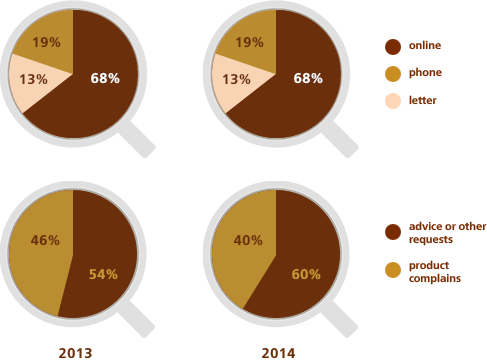Trust comes from quality
Consumers’ interest in coffee and new flavour experiences is growing alongside their expectations of coffee manufacturers. Flavour and quality are decisive, but increasingly frequently questions of social responsibility, like ecological aspects, ethics and organic sourcing, are factors in consumers’ choices.
Paulig’s coffee is now enjoyed in 13 different countries and our responsibility to the consumer extends into many different markets. We want to promote wellbeing throughout the coffee chain and to provide coffee fans with opportunities to make responsible choices.
In addition to quality and product safety, for Paulig responsibility means active dialogue with consumers and customers.
We regularly survey changes in consumption behaviour and flavour preferences as well as developments in coffee trends so that we can anticipate consumers’ wishes. One way to promote and verify responsibility is coffee certification. Here at Paulig, we aim to ensure the responsibility of all our coffee products whether it bears responsibility labelling or not.
Read more about our products and services report 2014.
Product complaints concerning coffee
In 2014, the ISO 22000 product safety management system at the Vuosaari and Tver roasteries was replaced with the more comprehensive FSSC 22000 system, which also received certification.
A total of 1,947 communications concerning coffee products were received. Of these, 656 were examined in the coffee laboratory and in production. The number of product complaints concerning roasted coffee was 14 per million kilos of coffee in Vuosaari and 3.7 in Tver. The number of complaints were down on the previous year, and the improvement was particularly striking in Tver (11.6 in 2013).
Enquiries received by consumer service 2014

TOP 3 questions for Consumer Service in Finland
1. How are coffee capsules and packaging laminate recycled?
There are instructions for recycling on the coffee package. The most popular coffee package for households, the 500g size, is sorted with mixed waste. The packages for professional use will be made aluminium-free by the end of 2015 and they will then be usable as energy waste.
The retail package for Cupsolo capsules is board, which can be recycled and placed in cardboard banks. The plastic capsules are categorised as mixed waste after use as they almost always still contain some coffee or biomass. When emptied of this, the capsules can be disposed of as energy waste.
2. How and how often should a coffee-maker or other coffee appliance be cleaned?
A glass coffee pot and filter should be washed with dishwashing liquid after each use. Coffee grease can be removed by washing the components in warm baking soda solution (3 tbs baking soda in 1 litre of water). It is worth following the equipment manufacturer's instructions about decalcifying with a suitable agent, for example, every time you open a new package of Melitta filter papers (80 pcs).
3. My coffee tastes different from its usual flavour, although I brewed it the same way as before. What's the problem?
Many factors affect the flavour of coffee, such as how fresh the ground coffee is, how clean the coffee-maker and other utensils are, and the temperature of the coffee. The correct amount of coffee to use for brewing is one coffee spoon (7-8 g) of coffee per cup (1.25 dl) and the water should be cold and fresh.
To keep the flavours of the coffee at their best, it's better to keep it tightly closed in its original package in a cool and dry place. Coffee should never be poured from the package into a storage jar, as this exposure to air will start the fat in the coffee to go rancid, affecting its flavour.
TOP 3 questions for Consumer Service in Russia
1. Are the Presidentti product family coffees the same in Finland as in Russia?
The recipes of the Paulig Presidentti product family have been tailored to local water and flavour preferences. The traditional Presidentti sold in Russia is darker and more finely ground than the Finnish Presidentti blend. Presidentti Gold Label and Presidentti Black Label are exactly the same coffee blends, but the grind is adjusted for local consumer preferences. All members of the Presidentti product family are 100% arabica coffees.
2. How is filter coffee brewed?
Pour fresh, cold water into the coffee-maker's water tank, using a clean measuring jug intended only for water. When you buy brewing equipment, check with the vendor that it heats water to a high enough temperature, i.e., 92-96 degrees Celsius. Hot water is best for extracting the right flavour and aromas from coffee.
Check that the filter and filter paper are the same size. Fold the edges of the filter paper along the seams and place it in the dry filter. Add one coffee measurement (7-8g) per cup (1.25 dl). Getting the amount right is important. Level out the coffee gently with the measurement spoon, do not shake it. Stir the liquid coffee with a spoon before serving.
3. How is coffee brewed by the 'turka' and in-cup methods?
You can find information on how to make coffee by the 'turka' and in-cup methods on our YouTube channel.
